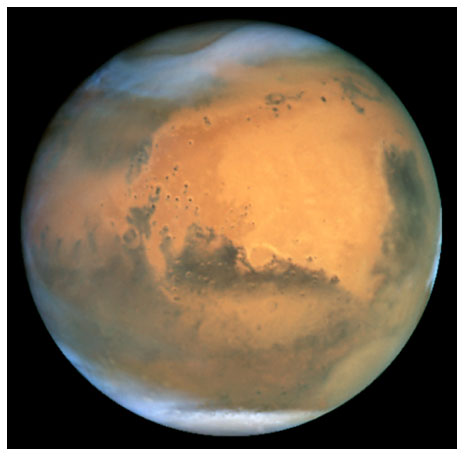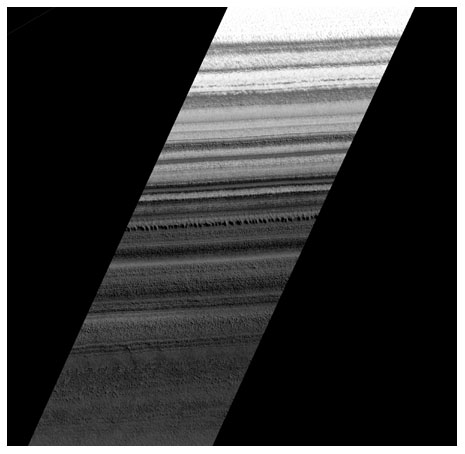Distributed September 25, 2002
For Immediate Release
News Service Contact: Scott Turner
Climate model for Earth also describes changes on Mars
A climate change theory for Earth can be applied to Mars and possibly to other Earth-like planets, report a Brown geoscientist and two colleagues in the Sept. 26 issue of Nature.
PROVIDENCE, R.I. — Orbit affects climate on Mars similar to the way it affects climate on Earth, say three scientists, who used a model of climate change on Earth to explain the layers of deposits in the polar regions of the Red Planet.
Their study appears in the Sept. 26 issue of Nature, and suggests that a climate change theory for Earth can also be applied to Mars and possibly to other Earth-like planets.
“The orbital theory of climate change has been successful in explaining changes in the Earth's climate, and we have used cores of the Greenland and Antarctic ice caps to reconstruct past climates and atmospheres on Earth,” said author Jack Mustard, associate professor of geological sciences at Brown University. “This means that we can now use the Mars caps in a similar way.”

The study also produced “a much better constraint on the time required to form the layers on the polar cap of Mars,” he said. “This has importance in understanding the Martian climate, and also the water cycles and history. We have so little information on the rates of change on Mars, but this gives us a solid marker.”
An image from the Hubble Space Telescope shows the full disk of Mars. Clouds and weather can be seen at the poles. [Image: NASA, Hubble Heritage Team (STScl/AURA) Hubble Space Telescope WFPC2 STScl-PRC01-24].
Jacques Laskar and Benjamin Levrard of the Astronomie et Systèmes Dynamiques in Paris joined Mustard as authors of the study.

The trio used orbital calculations and rotational parameters of Mars, new high-resolution images of its north pole terrain, and high-resolution topography data to correlate exposed layers of ice and dust with changes in climate, particularly the sum of solar radiation reaching the terrain. Their techniques mirrored those used for orbital-based climate studies on Earth.
This image, from an exposure of layers in the North Pole of Mars, is the actual image used in the analysis. Mustard and his colleagues say the alternating bright and dark bands are due to changes in climate recorded in these layers. The image is of an area about a mile across. [Image: NASA/JPL/Malin Space Science Systems].
Changes in the ratio of dust and ice over time are visible in the variations of brightness seen in the layers of polar deposits on Mars. First noticed in the earliest Mars missions, the layers were thought to be related to changes in climate possibly linked with the evolution of Mars' orbit such as the tilt of the axis and deviations in circularity. But the image resolution of past data was insufficient to resolve such key details.
High-resolution images from the Mars Global Surveyor allowed Mustard to resolve the fine detail and analyze the patterns. “After correcting the observations for topography, we produced a measure of the brightness of the layers as a function of depth,” he said. “We assume that depth equals time and thus can peer into the past. We then compared this record with the predicted amount of sunlight received at the pole over the last 10 million years, which varies with orbital evolution involving tilt and circularity.”
The researchers’ goal was to determine whether the sunlight record at the north polar cap of Mars correlated with the brightness-depth profile, and over what time frame. If the record correlated, that would solidify their hypothesis that the layers are due to climate changes related to orbit and allow the researchers to determine the formation rate of the layers.
“Indeed we find an excellent correlation and show that the 350-meter thick package of layers formed within the last 1 million years or so,” Mustard said. For the most recent 250-meter thick deposit of the north ice polar cap, the researchers found an average deposition rate of 0.05 cm/yr. “For the first time, we showed that the orbital theory of climate change has a record in the polar deposits on Mars.”
In orbit, Earth tilts about 23-25 degrees. In contrast, Mars tilts as little as 15 degrees and as much as 40 degrees, which is enough to redistribute moisture from polar caps to equatorial regions, Mustard said. In the 1970s, research by geologists at Brown first showed an orbital effect on climate change for Earth.
“This study further ties Mars and Earth as similar planets and strengthens the foundations to compare their climates and orbital evolutions,” Mustard said. “Showing that a planet with as strange an orbit as Mars has climate changes recorded in its surface means we have a tool in this orbital driver to explore what happens on the surface of planets with differences and similarities to Earth. And as we learn more about deposits on Mars we can compare what we find with what we know about Earth.”
The Centre Nationale de la Recherche Scientifique Programme Nationale de Planétologie and NASA’s Solar System Exploration programs supported the research.
######





